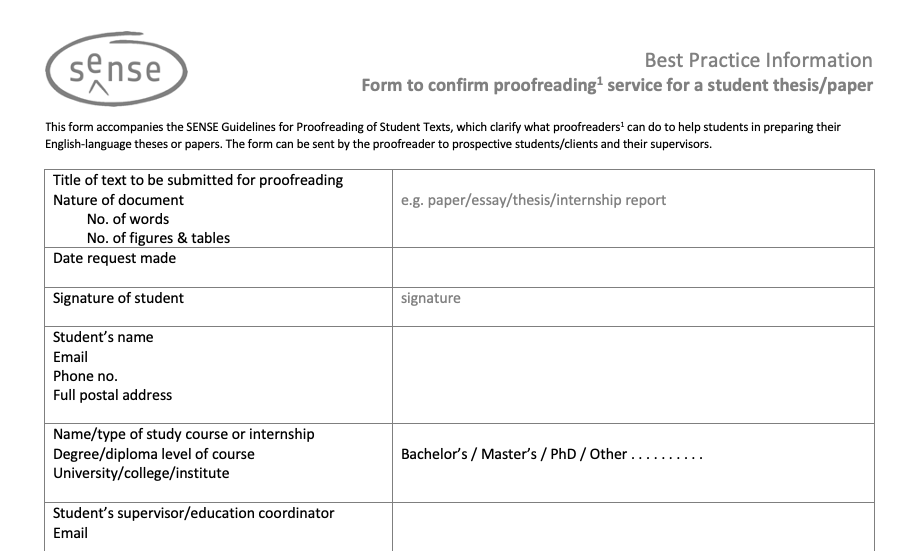[PDD 2021 session recap] The freedom of freelancing
Written by Yuven Muniandy
Have you ever wondered if it is feasible to work wherever you want to? Is it even possible to travel and build your business? Maaike Leenders answered these questions on digital nomadism and more at the 2021 SENSE Professional Development Day. After working in-house for almost five years, Maaike exchanged her office for the open road and has taken every opportunity to lead a digital nomad lifestyle. Based on her personal experience, she offered practical tips for beginners interested in becoming digital nomads.
Maaike started her presentation by dispelling some common myths associated with the digital nomad. Many think of digital nomads as young, attractive people working on laptops on picturesque islands like Bali or Crete. The problem is, this beachy, chill lifestyle is often confused with the wider concept of working remotely. According to Maaike, a digital nomad is a person making a living by working outside the conventional office environment, for longer or shorter periods at a time. They use the flexibility of their online career to travel and expand their horizons. Therefore, it is certainly not a life-hack that means you never have to work again. Additionally, this lifestyle is not everyone’s cup of tea.
Now that it’s clear what digital nomadism is not, let’s look at how one can become a digital nomad. First, we must ask “why do we want to pursue this niche?” and start a career as a digital nomad. There is more to life than work: family, friends, health issues, pets, and social responsibilities. These considerations lead to other questions: ‘how much do you want/need to work?’ and ‘how much you want to travel?’ Once these questions are answered, we are almost ready to say ‘sayonara’ to our old work lifestyle. It is vital to build up a cushion of money (cash buffer) to fund your start-up costs. It is also crucial to clear any financial arrears. Outstanding debts may be the barrier to becoming a digital nomad for a long time.
Other practical tips highlighted during the talk were related to income, ergonomic workspace, and having proper internet connections. Digital nomads often work for clients outside the time zones they travel to. Hence, it is necessary to organize your time to meet client needs. Like any profession, digital nomadism has its highs and lows. Maaike highlighted that it is important to be mindful of our emotions when we are earning a living as a digital nomad. Loneliness and homesickness are common emotional setbacks. Creating your own definition of freedom and learning to say ‘no’ are important for a balanced business and personal lifestyle.
At the end of her presentation, Maaike suggested resources that offer tips on how to travel and earn at the same time. These include books, Facebook groups, and volunteer organizations. There are also some excellent platforms for homestays, such as WWOOF, WorkAway, and HelpX. These platforms offer opportunities to stay abroad without paying ridiculous amounts of money. A take-home message from Maaike’s presentation is that everything always works out, even if it never goes according to plan. And that it is often better to start small.
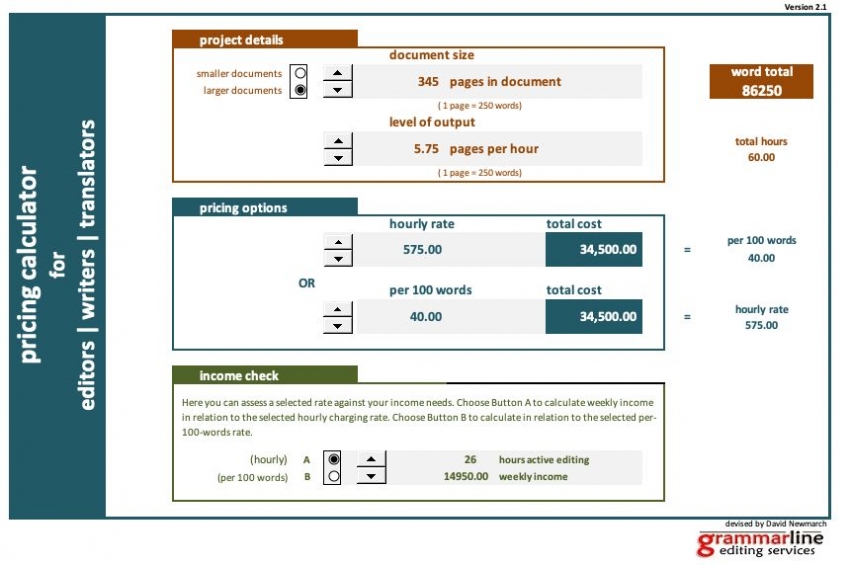
In the first part of her 2016 Best Practice series for eSense, Sally Hill talked about quoting for translation jobs. Here on the blog we are also re-publishing part 2, which continues the theme in relation to editing jobs. This article first appeared in eSense 42 (2016).
Before I get started on how to quote for editing jobs, let me touch on the thorny issue of the different levels of editing. After all, what I do as an editor may not be the same as what other editors in SENSE do, and this will of course affect the rate we charge and the time it takes to edit a text.
What do we mean by editing? What does the client expect?
In their chapter of the SENSE Best Practices Handbook entitled ‘The Ins and Outs of Editing’, co-authors Lee Ann Weeks and Ann Bless make the important distinction between ‘editing’ and ‘editors’ as referred to in the publishing world and the terms as used by most editors in SENSE. They also set out the difference between ‘proofreading’, ‘copy-editing’ and ‘substantive editing’, or what is generally understood by these terms. They use ‘proofreader’ to refer to the person who ‘compares the penultimate version of a text (ie, copy) with the final typeset/formatted version of the text (ie, galley proofs, page proofs, uncorrected proofs).’ This is similar to the definition used by the Chartered Institute of Editing and Proofreading [formerly known as The Society for Editors and Proofreaders, ed.] in the UK. Their website provides useful information on the distinction between copyeditors and proofreaders. A useful rule of thumb the CIEP provides is that a proofreader does about ten pages (some 300 words per page) an hour. If what you do takes considerably longer, you are probably copyediting and not proofreading. But ‘proofreading’ is also used in other contexts and I discuss this a bit more below.
You should be aware of the level of editing that you offer – and of course inform your clients of this. For new clients you could offer to edit the first page or so for free so they know what to expect. I sometimes include a sample edit with my quote so the client knows what they will be getting for the amount quoted. A client just expecting corrections regarding grammar, spelling, syntax and consistency (what I call language editing) may not appreciate me changing sentences around or commenting on content. As an editor used to substantive editing – and particularly used to educating PhD students while editing their work – I find it hard to limit myself to just language editing. If a new client asks me to do so I pass on the name of a colleague. For more on sample edits, see this forum discussion.
Or is what I do proofreading after all?
If you are more of a fixer and a flagger, then the other type of ‘proofreader’ may be a term more applicable to what you do. And if you proofread student manuscripts and PhD theses then you are also in luck – the SENSE Thesis Editing Guidelines developed by SENSE’s special interest group for members working in academia (UniSIG) are available on the website. They include such useful items as suggestions for acknowledgements and a form to clarify the help editors provide to students. In these guidelines the term proofreader is defined as ‘third party interventions (that entail some level of written alteration) on assessed work in progress’.[1]
So I know what I do but how long will it take me?
This is one of the hardest things about being a freelancer and a sample edit can really come in handy. For me, when a new manuscript comes in I can now estimate from the length and the quality of the English how long it will likely take me to edit it. But when I first started doing this work, I would edit one or two pages and time myself before getting back to the client with a quote. Sometimes this would backfire if the quote was too high and the client went elsewhere, but I learned quickly to quote a range. I tell clients that it may take me less time than the number of hours indicated but it will not cost them more than the maximum quoted, even if I go over the maximum number of hours (my loss). And when I find myself going off on tangents while editing a text that is just too interesting – when the time I spend on research (eg, reading up on certain molecular pathways or surgical interventions, or scanning other publications to see how other authors use certain terms) exceeds that strictly needed to edit the text – I do not bill the client for that extra time.
Quoting a range of hours not only allows you to invoice the client for less than the maximum if you don’t need all the hours (never a problem), it also gives you a bit of a safety net in case some sections of the text need extra attention. However, some editors quote and charge by the word, which has two advantages: both parties know beforehand what the costs will be, and as an editor you don’t have to keep track of the time spent on the text. A huge advantage if you are easily distracted by incoming emails (just close the program – works wonders!) or need to stop regularly while editing to answer the phone, feed the kids, hang up the washing, take the dog out, etc. Although you will need less time to prepare your quote, don’t forget to have a good look at the text before you start! This is of course also the case if you charge per hour. After all, some texts have multiple authors and you want to avoid nasty surprises.
Handy pricing calculator
You can of course use both hourly rates and word rates depending on what each client prefers. A post in April 2016 on the Facebook page of the Board of Editors in the Life Sciences’ points to a handy pricing calculator (pictured above) that allows you to see the equivalent fee per hour, per page, or per 100 words according to manuscript length and the editing level required according to ‘pages-per-hour’. Not only useful for editors but also for translators and writers. The Excel calculator is available for free via the website of the US-based Copyediting-L email discussion list and generously provided by David Newmarch.
It is a little cumbersome in that it is based on a page count, but if you have a word count then dividing by 250 will give you the page count to fill in. And you cannot actually type numbers in the spreadsheet so it takes a bit longer to fill in your rate and your speed. But... once you do, you can compare per word and per hour pricing options and also calculate what your weekly earnings are based on your rate and number of billable hours. And as I mentioned in part 1 of this series, paying attention to rates and earnings is an essential part of running your business.
I have not mentioned specific rates. What you charge will likely depend on your experience and should be a combination of what you feel you are worth and what your clients are prepared to pay. If you find it hard to know what to charge then just ask around – in my experience other SENSE members are happy to tell you what they charge, just not online. And that is one of the many reasons for attending SENSE workshops and SIG meetings and chatting with fellow language professionals. The results of SENSE’s 2012 rates survey indicate that rates for editing vary from €30 to €80 per hour, the average being around €55 (use the pricing calculator above to convert this to a word price).
[1] Nigel Harwood, Liz Austin & Rowena Macaulay (2012) Cleaner, helper, teacher? The role of proofreaders of student writing, Studies in Higher Education, 37:5, 569-584 http://dx.doi.org/10.1080/03075079.2010.531462
Those of you who proofread for students should not miss the upcoming UniSIG meeting, on Friday 8 October! Nigel Harwood, Professor of Applied Linguistics at the University of Sheffield, UK will be speaking on 'The ethics of "proofreading" student writing at UK universities'. His research interests include academic writing, English for specific and academic purposes, and TESOL materials/textbook design. He has recently published a series of articles on the proofreading of student academic writing. Registration for this event closes at 9:00h on 8 October.
|
Blog post by: Sally Hill LinkedIn: sally-hill-nl Twitter: SciTexts |
Sizzling Summer Series recap: Terminology Extraction and Management
Written by Jackie Senior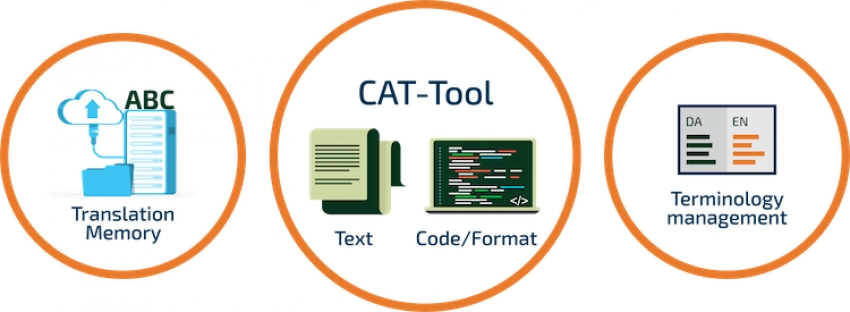
On 29 July 2021, I joined a group of fellow editors and translators to follow this SENSE workshop given by experienced CAT tool trainer Angelika Zerfass, who joined us online from her office in Germany.
Her workshop started with an introduction to terminology management before moving on quickly to some very practical points: the amount of time you need (or want) to spend on this aspect of your work, how to tackle extracting terms from text, how to structure your data, the useful metadata to include, advanced tips for using Excel, and much more.
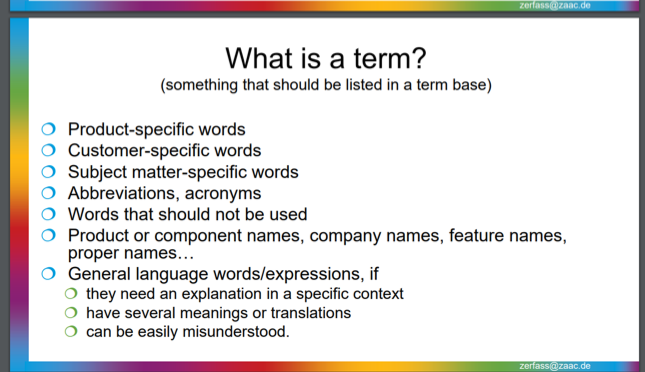

During her introduction, Angelika first stated the old adage ‘terminology is WORK’ – which is true whether you’re a multilingual or bilingual translator, or a monolingual editor. Her second essential point was that a system or database only becomes truly useful once it reaches a certain size. The tipping point of the number of hours put into building up your database versus when it becomes really useful to you will be different for everyone, but it’s certainly something to be aware of if you don’t have any system in place yet. Nevertheless, having some means of standardizing your output (per client/per topic/per document or publication) is strongly recommended for all text workers.
She then went on to tell us that the way in which you tackle your terminology management can depend on whether you adopt the viewpoint of a terminologist or of a user. For most SENSE members, practical issues will determine what you want from a terminology tool and how you can best structure it. This means starting by defining what you want to use your term database for. For example, for translators, terms cannot always be managed on a one-to-one basis, so it’s necessary to include fields for examples of their use and explanatory phrases.
Angelika went through some of the software tools that can be used for extracting terms (see list below). Some are free. She noted that the metadata you include with a term can prove essential in helping you decide on whether to use it in a certain setting. Metadata can include fields for source, reliability, dates for entry or added comments, examples of use, whether it’s required by a particular client, and for marking ‘forbidden’ terms or false friends.
Finally, Angelika summarized her points and noted that term lists and term databases are both useful and important for maintaining the quality of your work. And they will become even more important for improving or checking machine translation output!
Personally I found it interesting to see how these tools are developing, how well they interact with MS Word, and what one can use them for (having started my career with piles of dictionaries and a notebook next to my paper texts). For any language professional I think it’s essential you have some way of ensuring consistency between your texts and for individual clients. If you aim to work another five years or more, it’s certainly worth investing the effort to compile your own databases.
Terminology Extraction ToolsConcordance tools Term extraction tools / components of translation memory tools
Web-based term extraction
Check also: |
SENSE Summer Social: The wordsmith challenge!
Written by Naomi Gilchrist
On Friday 27 August 2021, a group of SENSE members got together in a Zoom session to have some fun and compete in a virtual wordsmith competition. The session was facilitated by SIG & Social Events Coordinator Maaike Leenders and hosted by Jacqueline from the 100-point challenge.
The Riddle
There were 16 participants who were divided over four teams. After the introduction and a quick briefing on how to play ‘The Riddle’, the teams were sent into their own breakout rooms.
For the next 45 minutes, we looked at ten unique problems, which would provide clues that we would need to solve one Master Riddle. It was a race against time and that time went by quickly…
The ten problems consisted of a mix of visual puzzles, riddles and logical reasoning. A little bit of everything really, all very engaging. Fortunately, the teams were also allowed to call in the help of our good friend Google.
The puzzles were not too difficult, but they weren’t extremely easy either. Our team was able to answer the questions within the allotted time – some of the other teams even finished with time to spare. They got to try their hand at tackling a few movie-related bonus questions.
The team that submitted their answers first and managed to solve the Master Riddle won the challenge. (There was no prize, it was just for fun.)
We all agreed that it was a very enjoyable session and a fun way to connect with other SENSE members. A lot of us language professionals usually work alone, so this was a good opportunity to engage in some teamwork.
Catching up
After the challenge was over, we joined a separate Zoom session and spent some time catching up while enjoying drinks and snacks.
I personally thought that it was a great way to spend a Friday afternoon: getting to know other SENSE members, testing our wits together and informally saying goodbye to the summer holiday months. My sincere thanks go out to the event organizers!
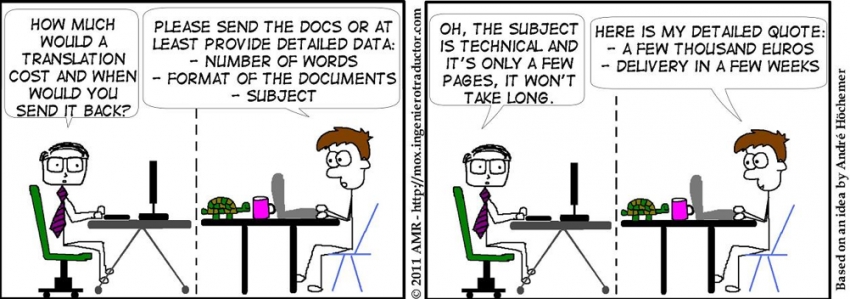
In part one of her 2016 series of business how-to’s for eSense, Sally Hill tackled the question of pricing strategies for translation, websites and otherwise.
A request comes in by email asking if you can do a job and you reply with a price and a deadline. If you’re a freelancer then this is something you probably do on a weekly basis. If the request is from an agency, there may be little room for negotiation in terms of pricing and deadline. But whoever you are dealing with, you still need to check the details of a job carefully to make sure the terms do not deviate from what you normally do or from what you have previously agreed with that particular client. Here, I talk about some of my own experiences when quoting for jobs as well as providing tips for other freelancers and links to further reading, both online and in print.
Examples from SENSE members
The difficulties that can arise when putting together a quote for a client are apparent from several questions posed on the SENSE forum. So let’s consider a couple of examples, starting with a question I myself asked about quoting for a transcreation job. A regular client had sent me 11 slogans to translate from Dutch to English, some with plays on words, assuming I would charge my regular per-word rate. Although I could have passed on this juicy job (creative juices juicy, not loadsamoney juicy) to someone more familiar with translating marketing texts, I knew the terminology from translating the client’s website and wanted to have a crack at it myself. But because I knew this could easily take me the best part of a morning, depending how much of a perfectionist I wanted to be, I wondered how many hours I could reasonably quote for it – especially since the client was assuming it was no more than about half an hour’s work.
I got some very useful advice from colleagues, both on the Forum and by phone, which basically came down to “charge by the hour and quote a range”. In the end, I quoted for 2-4 hours and charged the client for 2. Of course, this did not include the time spent deciding on how much to quote – I put this down to a learning experience/CPD useful for future jobs.
What did I learn from this? That it’s essential to find out what the client will use the transcreated texts for (internal memos only or global billboards?) as well as whether all the text will be used (my client selected only the five they liked most to print onto magnets for internal use). But also that you can sometimes overthink things and easily end up spending far more time quoting for a project than just getting on with it. For a client who offers me interesting well-paid projects, who I want to keep happy and impress with good service, I would now even consider doing such a job for free, or perhaps add on a little extra to my next invoice. So what you quote may also depend on your relationship with the client.
When quoting for a website translation, one SENSE colleague ran into the problem of doing an accurate word count. The client had suggested they give him access to the site via their portal in order to directly enter the translation online. But, of course, to come up with a quote he needed an idea of how long the project was going to take him, so a rough word count was needed. Entering the translation directly would also mean having none of the benefits of a translation tool or word processor – perhaps not even a spell checker!
Some colleagues suggested that an export into Word was the only way – to be done either by the client or the translator himself (and charged for accordingly of course). But it seems there are tools out there to at least help with the word count side of things. TransAbacus was mentioned as a possible website word counter. According to the TransAbacus website, this software “gets a website address or URL and returns the list of pages on the site, with the number of words for each one.” Sounds ideal, and at USD 34.95 for the full version, it’s not too pricy. A trial version is free and has the same functionality as the full version, but only displays the first 5 pages/files for the website being counted. If you have purchased and tested out TransAbacus, I’m sure other members would love to hear about your experiences with it on the Forum under the computer-related category.
This thread also side-tracked into counting words in PowerPoint files: apparently CAT tools can but other counting tools cannot. And do note that if you include in your quote a hefty fee for converting files to Word (from PDF or copy-pasting from a website) the client may miraculously find that they can do that themselves or find the relevant Word file.
If you’re a SENSE member, make sure to visit the Forum to read these other threads related to quoting:
- On counting words in a website for an editing quote
- The disadvantages of quoting a per-page rate
- A question on per-word rates for editing, plus some useful tips on calculating an average number of words per hour
Pricing problems
Apart from deciding how long something is likely to take you (in terms of text length or number of hours), you need to know how much to charge, whether this is per word, per hour or per project. Much has been written on deciding on a pricing strategy to match your target income. For translators I highly recommend from my own bookshelf both Chris Durban’s The Prosperous Translator, which has a chapter on pricing and value (Chris also spoke for SENSE in 2012), and Corinne Mckay’s How to Succeed as a Freelance Translator, which has some great tips about setting your rates and payment terms.
How do we get around the issue of a complicated or poorly written source text taking you longer to translate or edit than a straightforward or well-written text? No problem if you charge by the hour of course, but since most translators charge per word you need price zones – different rates for different texts.
On her blog Corinne Mckay suggests a green zone rate at which you would almost never turn down work, as long as the project is within your capabilities. The yellow zone is a rate that’s not ideal, but worth taking a look at – one you consider when work has been a little slow or if a project is particularly interesting, or when there’s some non-financial reason to consider it. Finally, the red zone is work that you turn down because it’s just too low-paying. To have a viable business, she says, you have to have a red zone.
This also ties in with what English-Swedish freelance translator Tess Whitty says in a podcast on her website Marketing Tips for Translators. In her podcast Tips on pricing strategies, negotiation and raising prices for Translators, Tess tells us that the better you are at negotiating your price, the better your rates will be. I agree – and I speak from experience – that giving your rates serious thought and making them part of how you market yourself as a business will put you in the right mindset for getting paid what you are worth. Such a mindset will give you confidence in negotiations with clients and hopefully help you to raise your rates as you gain more experience and become more specialized as a translator.
A pricing strategy for translation work that I am starting to hear more about is quoting on a per project basis. This is ideal for direct clients who don’t need – and are not interested in – a detailed breakdown but just want to know how much, period.
Another member told me about an Excel spreadsheet that she uses to calculate a total price for a new job. She copies the word counts from Practicount and from her CAT tool into the spreadsheet, then adds her per-word price and applies any discounts she thinks this client deserves (e.g. for similar files or for matches with previous translations) and the spreadsheet calculates the total price to the nearest 10 euros.
A final note relating to volunteering: if you like the sound of any of the books mentioned above, I highly recommend volunteering for our Society – those thankyou book tokens can come in handy!
This article first appeared in eSense 41 (2016). Cartoon reproduced with permission from Alejandro Moreno-Ramos, a freelance English & French to Spanish translator. ‘Mox is a young but well-educated translator. Two PhDs, six languages … and he hardly earns the minimum wage.’ The cartoons also feature his sidekick Mina (a turtle), Pam the evil project manager and various other characters. Please see Mox’s blog for more cartoons and to order his books.
|
Blog post by: Sally Hill LinkedIn: sally-hill-nl Twitter: SciTexts |
Sizzling Summer Series recap: applying Plain Language for accessible, user-friendly texts
Written by Daphne Visser-Lees
A small but enthusiastic group of language professionals gathered by Zoom to participate in this SENSE summer workshop. Speaking to us from South Africa, John opened with a quote from George Orwell: ‘The message is important, not the fancy language wrapped around it.’ And this set the tone for the workshop.
The group quickly established that we were all faced with similar problems. Even in this day and age, many writers continue to think that the more complex their writing is the better it is. Unfortunately in the process they often lose their natural (aka plain) voice completely. It is up to editors to render the authors’ messages readily understood at first reading by dispensing with obscurity, inflated vocabulary and convoluted sentence constructions.
Over the course of three interactive 50-minute sessions John led us through the application of Plain Language principles to real-life examples of poorly written English. We looked at adopting a reader focus, sentence length and complexity, noun strings, jargon, the use of the active and passive voice, and much, much more. John’s practical plain English approach included tips on ideal sentence and paragraph length, where and how to shorten sentences (a particularly useful section), and the value of vertical lists.
Whatever stage you are at in your editing career, I can thoroughly recommend taking part in this workshop. It not only provides concrete and useful tips for tackling text that at first sight seems impenetrable, but also gently encourages you to take an objective look at your own editing style. Although I like to think I keep up to date with modern English usage, I was somewhat surprised to realize how many archaic words I continue to use, but I am happy to adopt the suggested plain English alternatives.
Following the workshop, John sent us his PowerPoint presentation. Every single slide contains one or more useful nuggets of plain language advice. I will be keeping it easily accessible on my desktop to consult on those days when second language interference threatens to take the upper hand, or when dealing with a client who insists on using unnecessarily complex language. After all, as John reminded us, part of our job as editors is to educate the client by emphasizing that plain language gets the message across more effectively.
For more CPD opportunities, check out the SENSE Professional Development Days, on 18 and 25 September. This year's programme is all about horizontal knowledge-sharing and learning from your peers throughout your career. Topics include digital nomadism, the linguistics of wine, branding to money management, balancing multiple niches, collaborative translation, intercultural communication, the SENSE mentoring programme, and battling imposter’s syndrome. Tickets are €25 for members (non-members pay €40) and grant access to both days. Not a SENSE member? Click here to read about the benefits of joining the Society!
Sizzling Summer Series recap: Excel tips for self-employed language professionals
Written by Kay Dixon
Even at this late stage in my translating and editing career, the chance to learn more about Excel was one I didn’t want to miss. Another 12 SENSE members apparently felt the same way and we all dutifully installed ourselves at our two screens, started Zoom up and settled down for the Sizzling Summer Series workshop led by Maya Berger. Maya had sent round a set of spreadsheets prior to the workshop and had asked us to have two screens available, so that we could work on our own copies of the sheets on one screen and see what she was doing in the original sheets on the other.
We started with a quick introductory round and I was relieved to hear that I wasn’t the only novice. Maya had split the workshop into three parts: the basics and formatting a project timesheet; using a spreadsheet for expenses, CPD and income; and some tips for coping with multiple currencies and drawing up summaries and charts. Some of the participants had much more experience than I did, but even Maya’s explanation of the basics provided them with new tips. For me, it was a revelation to learn how to widen columns by double clicking on the dividing line between them. This also solves the problem of ‘###’ appearing instead of the value you want: the column is too narrow. How to copy a previously used formula to a new column was another useful tip. Apart from the familiar Ctrl C and Ctrl V, it’s possible to place your cursor at the bottom right corner of the cell containing the total and then drag it across to the new column, or up/down to a new row.
Locking cells can be a useful feature if you need to send your spreadsheet to someone else and you want to make sure certain parts are not tampered with. In my version of Excel, that feature is under the Review tab: Protect Sheet. You can add a password, but that is not mandatory.
Once we got on to multiple currencies, it was handy to learn how to convert one into the other and have that repeated across a range of rows. It became a bit more complicated (for me!) when we got onto summaries and charts. Here Maya explained how to include information on other tabs in the sheet to create a summary of income over time, for example, or to see which percentage of your income comes from each client. All this information can be converted into various charts, but I must confess that I got a bit lost at that point. My linguist genes are definitely stronger than my mathematical ones!
Maya remained very patient throughout and was happy to go back over things if anyone (not just me) had missed something. All in all, a very useful workshop, well explained. Now I just need some practice.
For more CPD opportunities, check out the SENSE Professional Development Days, on 18 and 25 September. This year's programme is all about horizontal knowledge-sharing and learning from your peers throughout your career. Topics include digital nomadism, the linguistics of wine, branding to money management, balancing multiple niches, collaborative translation, intercultural communication, the SENSE mentoring programme, and battling imposter’s syndrome. Tickets are €25 for members and €40 for non-members, and grant access to both days. Not a SENSE member? Click here to read about the benefits of joining the Society!
Sizzling Summer Series recap: Macros by the tourist route
Written by Marieke Krijnen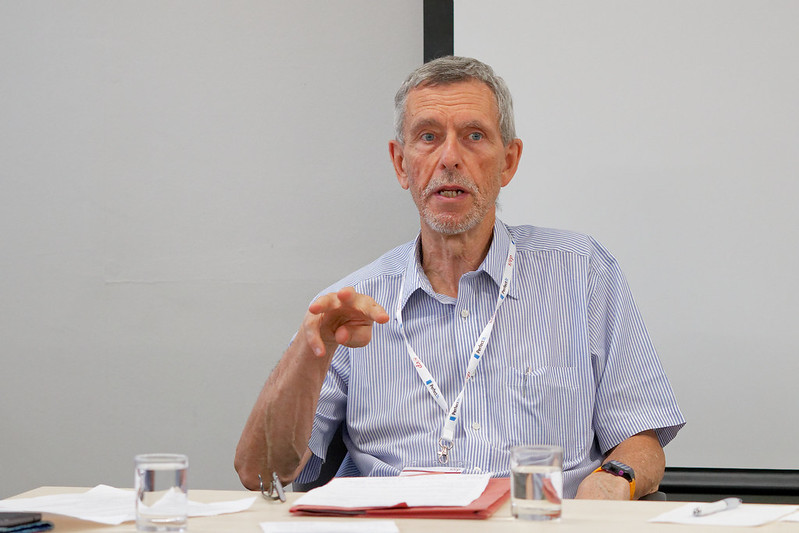
Paul Beverley at the 2019 SfEP conference, photo courtesy of CIEP.
On 9 July, Word macro man Paul Beverley initiated a handful of participants into the magic of macros, those nifty automated operations tools in Word that are created using the Visual Basic programming language. Paul has developed over 800 of these over the years, and has generously shared them with the editing community. Macros can automate a number of actions that editors need to perform on a regular basis, and they can save you hours of time and free up brainpower that can then be used to focus on the content of the text itself, instead of on technicalities and consistency issues.
Paul’s workshop, titled ‘Macros by the tourist route’, was aimed at absolute beginners and was intended to teach us how to essentially copy and paste Paul’s code into Word’s Visual Basic editor. The beauty of this is that no programming skills or very advanced technical skills are required; anyone can benefit from the power of macros if they learn how to copy and paste Paul’s code into Word.
We began by discussing our various operating systems, Word versions and experiences with macros. Once Paul had obtained an idea of our capabilities and experience and explained the basics of macros to us, he asked us to open a Word document he had sent us a download link to in advance.The documents contain step-by-step instructions with screenshots. I found them to be incredibly clear and helpful.
By following the steps in these documents, which are freely available to everyone in both a Windows and a Mac version, we learned how to record a basic macro and how to open Word’s Visual Basic editor. We then copied and pasted macro code into the editor, and tested our new macro. We also learned how to assign a keystroke to it, so we could execute the macro quickly.
Next, Paul explained where we could find the text of other macros (on his website) and let us carry out the rest of the steps in the instruction document. I learned how to install a macro that fetches Paul’s macros in one click by just typing their name into Word, which was pretty cool. We also learned how to install some of Paul’s popular macros, DocAlyse, ProperNounAlyse, and other information-based tools. These analyse a document without making any changes.
Paul then briefly introduced macros that belong to the ‘global change’ tools category, including his powerful FRedit macro. This is a global, advanced find-and-replace macro that is incredibly useful but also a bit trickier to learn how to use. However, the information-based macros are already incredibly useful, and I’ve really benefited from using a number of them already. A client of mine, for example, wanted to provide a glossary of Arabic terms at the end of her manuscript. We had italicized Arabic terms throughout the document, so I used a macro called ‘ItalicWordList’ to provide her with a list of all italic terms in the document. While I had also kept a style sheet of these terms, the macro took only a few seconds to provide a list of all italic terms against which the style sheet could be checked for completeness.
If anyone is interested in learning more about macros, Paul’s website and YouTube channel are good places to start.
For more CPD opportunities, check out the SENSE Professional Development Days, on 18 and 25 September. This year's programme is all about horizontal knowledge-sharing and learning from your peers throughout your career. Topics include digital nomadism, the linguistics of wine, branding to money management, balancing multiple niches, collaborative translation, intercultural communication, the SENSE mentoring programme, and battling imposter’s syndrome. TTickets are €25 for members and €40 for non-members, and grant access to both days. Click here to read about the benefits of joining the Society!
Editing made easier: PerfectIt teams up with CMOS
Written by Alison Gibbs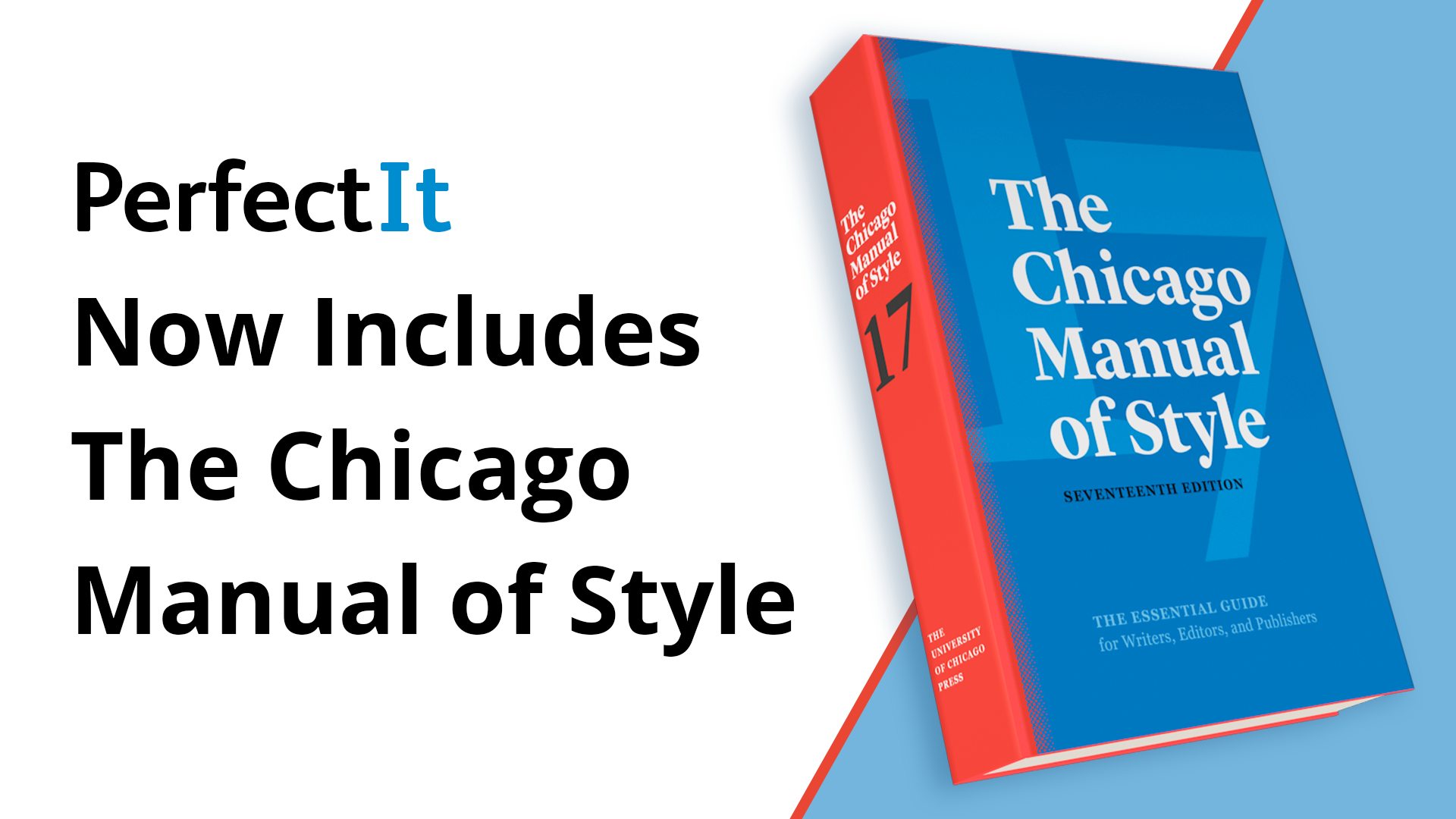
Although I’ve been using PerfectIt for many years and can’t imagine editing without it, I’ve tended just to use it as a final check before texts are ‘good to go’. Consulting a style manual has been something I’ve done before using PerfectIt, to check consistency and generally tidy things up. But this can be time-consuming, and so having a style manual incorporated into PerfectIt is attractive. That way, the issue presents itself automatically instead of you first having to search for the grammatical or stylistic point in the manual and then making a decision.
The latest version of PerfectIt was easy to install, as was the link to the Chicago Manual of Style (CMOS). You log in to the Intelligent Editing website to link the two accounts. Then you open PerfectIt in Word, click on the CMOS option in the list of styles (all in the usual place) and you’re up and running.
O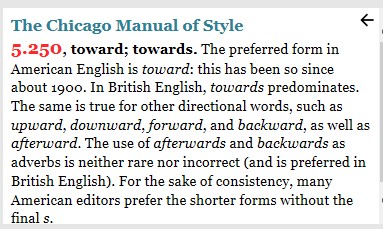 n the versions of English spoken on either side of the pond there are things we know we know, and things we know we don’t know. That’s when style guides come in handy. But then there are the ‘unknown unknowns’, when it wouldn’t have occurred to me to question some things the CMOS flagged up as ‘Britishisms’ or non-standard. When testing the new feature, I therefore selected some articles previously edited in UK English to see:
n the versions of English spoken on either side of the pond there are things we know we know, and things we know we don’t know. That’s when style guides come in handy. But then there are the ‘unknown unknowns’, when it wouldn’t have occurred to me to question some things the CMOS flagged up as ‘Britishisms’ or non-standard. When testing the new feature, I therefore selected some articles previously edited in UK English to see:
- what would show up if I switched to the standard US spelling option in PerfectIt;
- what else would be highlighted by the CMOS (the ‘added value’).
In addition to highlighting inconsistencies and non-preferred spellings in the usual way, the main benefit of the new CMOS add-on is that it automatically provides a more detailed explanation and some context, including the reference to CMOS in case you want to know even more. I like the way PerfectIt presents the CMOS explanation in a bite-size block, as this protects against language-geeky tendencies to get waylaid by other information long after you’ve resolved the point at issue.
A useful tip for non-US users wanting the CMOS to check their style without applying US spelling is to run PerfectIt twice (it goes really quickly): firstly using CMOS and secondly using, say, the UK spelling option, but then only the ‘Spelling Consistency’ check (deactivate all the other checks in ‘Choose Checks’).
If you already use PerfectIt and have a CMOS subscription, using CMOS within PerfectIt simply saves time at no extra cost. A no-brainer. But if you don’t yet have a CMOS subscription, whether you want to pay the annual fee (about USD 40) on top of your PerfectIt subscription will depend on how often you use that style.
As nearly all my clients want UK spelling and style, I didn’t previously have a CMOS subscription. But although I normally try to steer clients towards (or toward, if I follow the CMOS suggestion) British English and spelling, I was really glad to have to use CMOS this week – a client suddenly wanted US English for one assignment. And I’m rather hoping there’ll be more requests for US style in the next few weeks. That’ll make it much easier to decide whether to opt for a subscription when the free trial ends. And if those requests don’t materialize, I can just enjoy some easier decision-making within rather than outside PerfectIt.
Utrecht SIG report: book swap and pancakes at Theehuis Rhijnauwen
Written by Jenny Zonneveld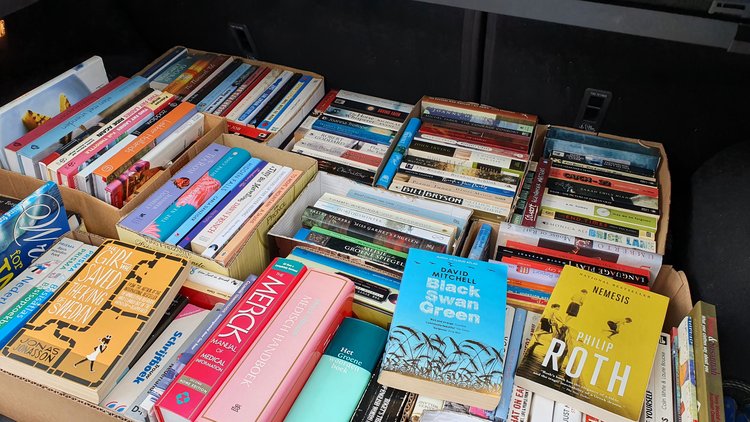
The Utrecht SIG held its first in-person meeting for more than 18 months on Wednesday 14 July. Besides being a corona-proof socially-distanced affair, it was gezellig and convivial, and ‘voor herhaling vatbaar’. We met in the car park at Theehuis Rhijnauwen, where we chatted and swapped notes as well as books. Some had a whole car boot full and others, who had come by bike, had brought just a few. Many books found new owners and everyone took something new to read home with them.
We then proceeded to the restaurant, where we could all sit together at a large table outside. After delicious pancakes and scrumptious desserts...
 |
 |
...some of us walked around the park, recording our daily Ommetje. (If you'd like to join the SENSE walking team challenge, simply download the app and join using the team code LAEFG.)
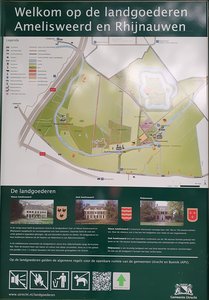 |
 |
The next Utrecht SIG meeting is planned for 8 September. Keep an eye on the event calendar for details.
